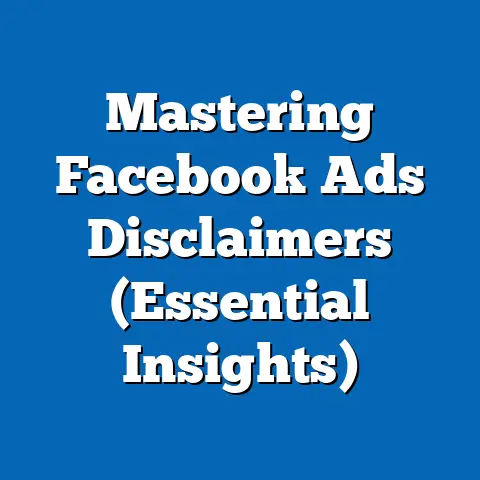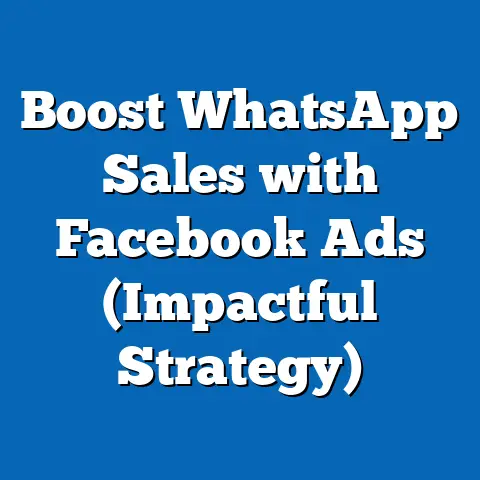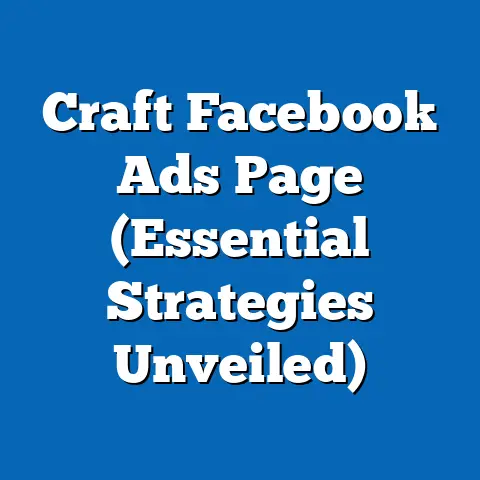Boost Sales with Facebook Catalogue Ads (Proven Strategies)
Imagine a small business owner, Sarah, sitting in her cozy home office in 2023, surrounded by handmade jewelry pieces she’s crafted with care. With limited resources for traditional advertising, she turns to her laptop, uploads her product images to a Facebook Catalogue, and within hours, her creations are showcased to thousands of potential customers scrolling through their feeds. This isn’t a distant dream but a reality shaped by the digital marketing revolution, where platforms like Facebook have transformed how businesses—big and small—reach their audiences.
Facebook Catalogue Ads, introduced as a dynamic advertising tool in the mid-2010s, represent a pivotal shift in e-commerce and digital marketing. Emerging alongside the rise of social media as a commercial hub, these ads allow businesses to display multiple products directly in users’ feeds, leveraging advanced algorithms to target the right customers at the right time. This innovation arrived at a time when global internet penetration soared past 50% (as reported by Statista in 2015), and mobile usage became the dominant way people accessed social platforms, fundamentally altering consumer behavior.
The societal implications of this shift are profound. For entrepreneurs like Sarah, Catalogue Ads democratize access to global markets, breaking down barriers once reserved for corporations with hefty marketing budgets. Yet, this also raises questions about data privacy, market saturation, and the digital divide—issues that continue to shape the discourse around social media advertising. This article delves into the mechanics of Facebook Catalogue Ads, explores proven strategies to boost sales, and examines the broader implications for businesses and consumers in an increasingly connected world.
Historical Context: The Evolution of Digital Advertising
To understand the significance of Facebook Catalogue Ads, we must first trace the evolution of digital advertising. In the early 2000s, online ads were primarily static banners and pop-ups, often seen as intrusive and poorly targeted. Google’s introduction of AdWords in 2000 marked a turning point, using keyword-based targeting to align ads with user intent, setting the stage for personalized advertising.
Facebook entered the scene with its advertising platform in 2007, initially offering simple sidebar ads. As the platform grew to over 1 billion users by 2012 (according to Facebook’s own reports), it became a goldmine for advertisers seeking to tap into detailed user demographics. The launch of dynamic ads in 2015, which later evolved into Catalogue Ads, was a game-changer, allowing businesses to upload entire product catalogs and automatically generate ads tailored to individual users based on their browsing history and interests.
This development coincided with key societal shifts. The proliferation of smartphones—reaching 2.5 billion users worldwide by 2019 (Statista)—meant consumers were constantly connected, browsing products on the go. E-commerce sales surged, with global figures hitting $3.5 trillion in 2019 (eMarketer), and social media platforms became virtual storefronts. Catalogue Ads capitalized on this trend, blending seamless shopping experiences with targeted marketing, forever changing how businesses approach sales in the digital age.
What Are Facebook Catalogue Ads? A Technical Overview
At their core, Facebook Catalogue Ads are a type of dynamic advertisement that pulls product information directly from a business’s catalog uploaded to the platform. Unlike static ads, these are automatically generated based on user behavior, such as items viewed on a website or added to a cart. They can appear in various formats, including single images, carousels, or collections, and are displayed across Facebook, Instagram, Messenger, and the Audience Network.
Setting up Catalogue Ads involves creating a product feed—a structured file containing details like product names, prices, images, and URLs. This feed integrates with Facebook’s Business Manager, where businesses can define target audiences using parameters like location, interests, or past interactions. The platform’s algorithm then matches products to users most likely to purchase, optimizing for conversions.
The power of Catalogue Ads lies in their scalability and personalization. A business with thousands of products can showcase relevant items to millions of users without manually creating individual ads. According to Facebook’s internal data (2022), businesses using Catalogue Ads report up to a 30% increase in return on ad spend (ROAS) compared to traditional ad formats, highlighting their effectiveness in driving sales.
Proven Strategies to Boost Sales with Facebook Catalogue Ads
Harnessing the full potential of Catalogue Ads requires strategic planning and execution. Below are proven strategies, backed by data and real-world case studies, to maximize sales outcomes.
1. Optimize Your Product Feed for Accuracy and Appeal
Include detailed attributes like size, color, and availability to avoid mismatched ads. Regularly update your feed to reflect inventory changes, preventing customer frustration from seeing out-of-stock items. Tools like DataFeedWatch or Feedonomics can automate feed optimization, ensuring compliance with Facebook’s strict formatting guidelines.
2. Leverage Dynamic Retargeting for Higher Conversions
One of the standout features of Catalogue Ads is dynamic retargeting, which targets users who have already interacted with your brand. For instance, if a user viewed a pair of shoes on your website but didn’t purchase, a Catalogue Ad can display that exact product or similar items in their feed.
Studies by Criteo (2022) reveal that retargeted ads have a click-through rate (CTR) 76% higher than standard display ads. To maximize this, set up pixel tracking on your website to capture user behavior, and create custom audiences for retargeting campaigns. Combine this with urgency-driven copy like “Limited Stock!” to encourage immediate action.
3. Segment Audiences for Precision Targeting
Facebook’s robust targeting options allow businesses to segment audiences based on demographics, interests, and behaviors. Instead of a one-size-fits-all approach, tailor your Catalogue Ads to specific groups. For example, a fashion retailer might create separate campaigns for teenagers interested in streetwear and professionals seeking formal attire.
Use lookalike audiences to expand your reach—Facebook identifies users similar to your existing customers, increasing the likelihood of conversions. A 2021 report by Hootsuite found that campaigns using lookalike audiences achieved a 25% lower cost per acquisition (CPA) compared to broad targeting.
4. Experiment with Ad Formats and Placements
Catalogue Ads offer flexibility in how products are displayed. Carousel ads, which showcase multiple products in a swipeable format, are particularly effective for e-commerce, with a 15% higher engagement rate than single-image ads (Facebook Business, 2022). Collection ads, which combine a cover image with a grid of products, create an immersive shopping experience ideal for mobile users.
Test different placements—News Feed, Stories, or Instagram Explore—to identify where your audience engages most. Automated placement optimization, a feature in Facebook Ads Manager, can distribute your budget across platforms for maximum impact.
5. Incorporate Seasonal and Promotional Campaigns
Timing is critical in e-commerce, and Catalogue Ads can be tailored to capitalize on seasonal trends or promotions. During events like Black Friday or Christmas, update your catalog with discounted items and use ad copy that highlights limited-time offers. A study by Adobe Analytics (2022) found that holiday campaigns using dynamic ads saw a 35% uplift in sales compared to non-seasonal periods.
Additionally, create urgency with countdown timers or flash sale notifications within ads. This taps into the fear of missing out (FOMO), driving quicker purchase decisions.
6. Analyze and Optimize with Data-Driven Insights
Continuous improvement is key to sustained success with Catalogue Ads. Use Facebook Ads Manager to track metrics like CTR, conversion rate, and ROAS. Identify underperforming ads and adjust elements like images, copy, or audience targeting to improve results.
A/B testing is a powerful tool—test variations of your ads to determine what resonates most with your audience. According to a 2023 report by WordStream, businesses that regularly optimize their campaigns see a 20-30% improvement in ad performance over time.
Case Studies: Real-World Success with Catalogue Ads
To illustrate the impact of these strategies, let’s explore two real-world examples.
First, consider an online fashion retailer, “TrendThread,” which implemented Catalogue Ads in 2021. By optimizing their product feed with high-resolution images and detailed descriptions, and using dynamic retargeting, they achieved a 40% increase in sales within three months. Their focus on carousel ads for mobile users further boosted engagement, aligning with the 80% of their audience accessing Facebook via smartphones.
Similarly, “GadgetHub,” a tech accessory store, leveraged seasonal campaigns during the 2022 holiday season. By promoting discounted bundles through Collection ads and targeting lookalike audiences, they reported a 50% higher ROAS compared to their previous static ad campaigns. These examples underscore how strategic use of Catalogue Ads can yield tangible results across industries.
Societal and Economic Implications of Catalogue Ads
The rise of Facebook Catalogue Ads extends beyond individual business success, influencing broader societal and economic trends. On one hand, they empower small businesses and entrepreneurs by providing affordable, scalable marketing solutions. This aligns with the gig economy’s growth—by 2023, over 57 million Americans were engaged in freelance work (Upwork), many relying on platforms like Facebook to promote their products or services.
However, this democratization comes with challenges. The reliance on user data for targeting raises privacy concerns, especially post-2018 Cambridge Analytica scandal, which exposed how personal information could be misused. Regulations like the General Data Protection Regulation (GDPR) in Europe and the California Consumer Privacy Act (CCPA) have since tightened data usage rules, forcing businesses to adapt their ad strategies.
Economically, Catalogue Ads contribute to the shift toward digital-first commerce. Global e-commerce sales are projected to reach $6.3 trillion by 2024 (Statista), with social media ads playing a significant role. Yet, this also exacerbates the digital divide—businesses without the resources or know-how to leverage these tools risk being left behind, widening inequality in the marketplace.
Cultural Shifts and Consumer Behavior
Culturally, Catalogue Ads reflect and reinforce the move toward instant gratification in consumer behavior. With products just a click away, users expect seamless shopping experiences, a trend amplified by the COVID-19 pandemic when online shopping surged by 44% in 2020 (IBM Retail Index). This “see now, buy now” mentality shapes how brands communicate, prioritizing speed and convenience.
At the same time, the constant exposure to personalized ads influences societal perceptions of materialism and consumption. Research from the Journal of Consumer Psychology (2021) suggests that frequent ad exposure can heighten impulse buying, raising questions about sustainability and overconsumption in a hyper-digital world.
Workplace and Marketing Industry Impacts
For marketing professionals, Catalogue Ads have redefined skill requirements. Proficiency in data analytics, feed management, and audience segmentation is now essential, shifting the industry toward tech-savvy roles. According to LinkedIn’s 2023 Jobs Report, demand for digital marketing specialists grew by 20% year-over-year, driven by tools like Facebook Ads.
Businesses, too, must adapt internal processes. Integrating Catalogue Ads often requires collaboration between marketing, IT, and sales teams to ensure accurate product data and cohesive branding. This cross-functional approach can streamline operations but demands investment in training and technology.
Challenges and Limitations of Catalogue Ads
Despite their advantages, Catalogue Ads are not without limitations. High competition on Facebook means ad costs can escalate, particularly during peak seasons—average cost-per-click (CPC) rose to $1.72 in Q4 2022 (WordStream). Small businesses with limited budgets may struggle to compete with larger players.
Technical barriers also exist. Creating and maintaining a product feed can be complex for those without digital expertise, and errors in feed data can lead to wasted ad spend. Additionally, algorithm changes on Facebook can disrupt campaign performance overnight, requiring constant vigilance.
Lastly, ad fatigue is a growing concern. As users are bombarded with personalized ads, effectiveness can wane—research by HubSpot (2022) indicates that 74% of consumers feel frustrated when content is irrelevant, even if targeted. Balancing frequency and relevance is crucial to avoid alienating potential customers.
Forward-Looking Insights: The Future of Catalogue Ads
Looking ahead, the trajectory of Facebook Catalogue Ads will likely be shaped by technological advancements and regulatory landscapes. The integration of artificial intelligence (AI) promises even more precise targeting, with Meta (Facebook’s parent company) investing heavily in AI-driven ad tools. Augmented reality (AR) features, such as virtual try-ons for clothing or furniture, could further enhance the shopping experience, blurring the line between online and in-store.
However, privacy regulations will continue to challenge advertisers. Apple’s App Tracking Transparency (ATT) framework, introduced in 2021, already reduced ad tracking capabilities, with Meta reporting a $10 billion revenue loss in 2022 due to signal loss. Businesses must pivot toward first-party data strategies, like email lists or loyalty programs, to maintain targeting efficacy.
Consumer trends also point to a demand for authenticity. Future campaigns may need to balance automation with human-centric storytelling, emphasizing brand values alongside product features. While the path forward is uncertain, adaptability will be key—those who innovate within constraints will likely lead the next wave of digital commerce.
Conclusion
Facebook Catalogue Ads have emerged as a transformative tool for businesses aiming to boost sales in a crowded digital marketplace. From optimizing product feeds to leveraging dynamic retargeting and seasonal campaigns, the strategies outlined in this article offer a roadmap for success, grounded in data and real-world applications. Yet, their impact extends beyond revenue, influencing societal norms, economic structures, and cultural attitudes toward consumption.
As we navigate the evolving landscape of digital advertising, the balance between personalization and privacy, innovation and accessibility, will shape how Catalogue Ads—and social media marketing at large—develop. While challenges like ad fatigue and regulatory hurdles loom, the potential for growth remains vast for those willing to adapt. In this dynamic environment, businesses like Sarah’s jewelry shop can thrive, turning clicks into customers and dreams into reality, one ad at a time.






